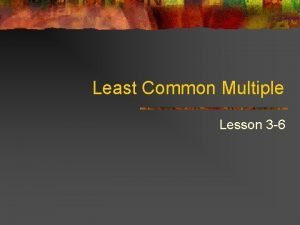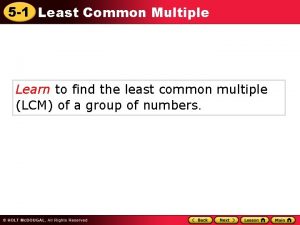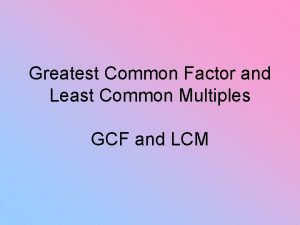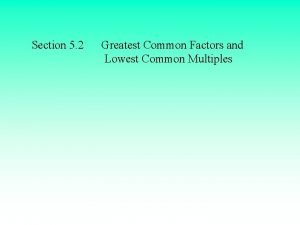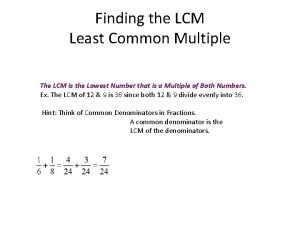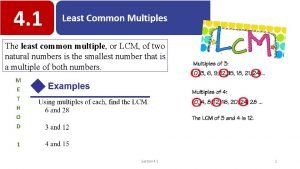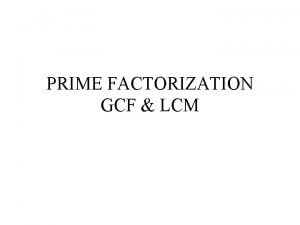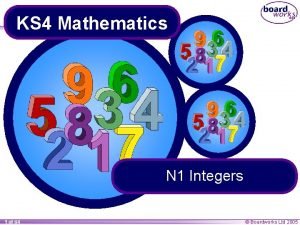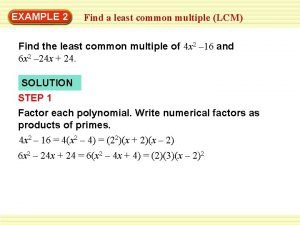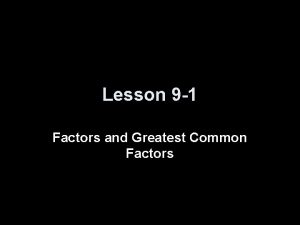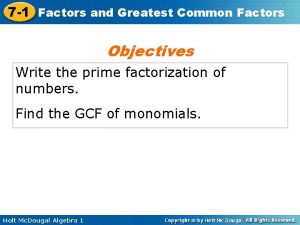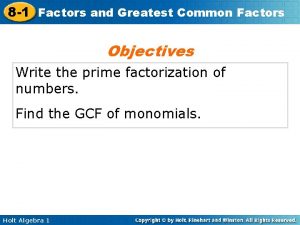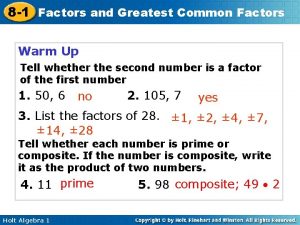Section 5 2 Greatest Common Factors and Lowest




















- Slides: 20

Section 5. 2 Greatest Common Factors and Lowest Common Multiples

Greatest Common Factor (GCF) Definition: The GCF of two whole numbers a and b is the largest whole number c that can divide into both a and b. Methods for finding GCF(a, b) (I) Set intersection method – depends on listing all factors of a and b.

Greatest Common Factor (GCF) Definition: The GCF of two whole numbers a and b is the largest whole number c that can divide into both a and b. Methods for finding GCF(a, b) (I) Set intersection method – depends on listing all factors of a and b. example: to find the GCF(12, 18)

Greatest Common Factor (GCF) Definition: The GCF of two whole numbers a and b is the largest whole number c that can divide into both a and b. Methods for finding GCF(a, b) (I) Set intersection method – depends on listing all factors of a and b. example: to find the GCF(12, 18) factors of 12: 1, 2, 3, 4, 6, 12.

Greatest Common Factor (GCF) Definition: The GCF of two whole numbers a and b is the largest whole number c that can divide into both a and b. Methods for finding GCF(a, b) (I) Set intersection method – depends on listing all factors of a and b. example: to find the GCF(12, 18) factors of 12: 1, 2, 3, 4, 6, 12. factors of 18: 1, 2, 3, 6, 9, 18.

Greatest Common Factor (GCF) Definition: The GCF of two whole numbers a and b is the largest whole number c that can divide into both a and b. Methods for finding GCF(a, b) (I) Set intersection method – depends on listing all factors of a and b. example: to find the GCF(12, 18) factors of 12: 1, 2, 3, 4, 6, 12. factors of 18: 1, 2, 3, 6, 9, 18. Clearly the red numbers are the common factors and 6 is the largest, GCF(12, 18) = 6

Greatest Common Factor (GCF) Methods for finding GCF(a, b) (method I is straight forward and easy to learn but slow for larger numbers) (II) Factorization method – depends on the complete factorization of a and b. example: to find the GCF(24, 180) 24 = 2× 2× 2× 3, 180 = 2× 2× 3× 3× 5 and by the “Greedy algorithm”, we pick all the prime factors common to both numbers (including multiplicities) GCF(24, 180) = 2× 2× 3

One more exercise Find the GCF(882, 924) (click for answer. ) Answer: 882 = 2× 3× 3× 7× 7 924 = 2× 2× 3× 7× 11 Hence GCF(882, 924) = 2× 3× 7 = 42

(method II is still difficult to use if the numbers are too large and difficult to factorize. ) (III) Euclidean Algorithm – depends on reducing large numbers to smaller ones. Theory: if a > b, then GCF(a, b) = GCF(a - b, b) in other words, we can reduce the larger number by subtracting it with the smaller one, without changing the GCF. (click to scroll up)

(method II is still difficult to use if the numbers are too large and difficult to factorize. ) (III) Euclidean Algorithm – depends on reducing large numbers to smaller ones. Theory: if a > b, then GCF(a, b) = GCF(a - b, b) in other words, we can reduce the larger number by subtracting it with the smaller one, without changing the GCF.

(III) Euclidean Algorithm – depends on reducing large numbers to smaller ones. Theory: if a > b, then GCF(a, b) = GCF(a - b, b) in other words, we can reduce the larger number by subtracting it with the smaller one, without changing the GCF. Example: GCF(481, 296) = GCF(481 – 296, 296) = GCF(185, 296 – 185) = GCF(185, 111) = GCF(74, 37) = GCF(37, 37) = 37

Lowest Common Multiple (LCM) Definition: The LCM of two whole numbers a and b is the smallest whole number c that is divisible by both a and b. Methods for finding LCM(a, b) (I) Set intersection method – depends on listing small multiples of a and b. example: to find the LCM(15, 24) multiples of 15: multiples of 24:

Lowest Common Multiple (LCM) Definition: The LCM of two whole numbers a and b is the smallest whole number c that is divisible by both a and b. Methods for finding LCM(a, b) (I) Set intersection method – depends on listing small multiples of a and b. example: to find the LCM(15, 24) multiples of 15: 15, 30, 45, 60, 75, 90, 105, multiples of 24: 24, 48, 72, 96, 120,

Lowest Common Multiple (LCM) Definition: The LCM of two whole numbers a and b is the smallest whole number c that is divisible by both a and b. Methods for finding LCM(a, b) (I) Set intersection method – depends on listing small multiples of a and b. example: to find the LCM(15, 24) multiples of 15: 15, 30, 45, 60, 75, 90, 105, 120. multiples of 24: 24, 48, 72, 96, 120,

Lowest Common Multiple (LCM) Definition: The LCM of two whole numbers a and b is the smallest whole number c that is divisible by both a and b. Methods for finding LCM(a, b) (I) Set intersection method – depends on listing small multiples of a and b. example: to find the LCM(15, 24) multiples of 15: 15, 30, 45, 60, 75, 90, 105, 120. multiples of 24: 24, 48, 72, 96, 120, Therefore LCM(15, 24) = 120.

Lowest Common Multiple (LCM) Methods for finding LCM(a, b) (II) Factorization method – a “thrifty” algorithm example: to find the LCM(875, 1225) 875 = 5× 5× 5× 7 1225 = 5× 5× 7× 7 Analogy: Your math teacher requires you to bring 3 pencils and 1 highlighter to class, your History teacher requires you to bring 2 pencils and 2 highlighters. What is the minimum set of pens you need to bring if you have both classes in one day? Ans: 3 pencils and 2 highlighters.

Lowest Common Multiple (LCM) Methods for finding LCM(a, b) (II) Factorization method – a “thrifty” algorithm example: to find the LCM(875, 1225) 875 = 5× 5× 5× 7 1225 = 5× 5× 7× 7 Analogy: Your math teacher requires you to bring 3 pencils and 1 highlighter to class, your History teacher requires you to bring 2 pencils and 2 highlighters. What is the minimum set of pens you need to bring if you have both classes in one day? Ans: 3 pencils and 2 highlighters. LCM(875, 1225) = 5× 5× 5× 7× 7

Lowest Common Multiple (LCM) Methods for finding LCM(a, b) (II) Factorization method – Another example: to find the LCM(60, 126) 60 = 2× 2× 3× 5 126 = 2× 3× 3× 7 Answer: 2× 2× 3× 3× 5× 7

Lowest Common Multiple (LCM) Methods for finding LCM(a, b) (III) “Mechanical method” – using a formula a´b LCM (a, b) = GCF (a, b) Example: Find the LCM of 481 and 296. Answer: we have calculated before that GCF(481, 296) = 37, therefore LCM(481, 296) = (481× 296) ÷ 37 = 3848

Lowest Common Multiple (LCM) Example: Your neighbor has two dogs - one named Sparky and one named Skippy. They both like to bark and both have a pattern. Sparky will bark for a while every 15 minutes once started, and Skippy does the same every 18 minutes. One night they both started barking at 9 pm because a cat passed by. When did they bark together again that night?
 Factors to 18
Factors to 18 What are the factors for 54
What are the factors for 54 Multiples of 9 and 21
Multiples of 9 and 21 What are all the factors of 48
What are all the factors of 48 Factors if 7
Factors if 7 What are the factors of 8
What are the factors of 8 Lcm of 48 and 60
Lcm of 48 and 60 Lowest common multiple factor tree
Lowest common multiple factor tree Lowest common multiple of 80 and 60
Lowest common multiple of 80 and 60 Common multiple definition
Common multiple definition Lowest common multiple of 6 and 8
Lowest common multiple of 6 and 8 Common denominator of 8 and 5
Common denominator of 8 and 5 Gcf of 72 and 90
Gcf of 72 and 90 Lowest common factor
Lowest common factor Lcm of numbers from 1 to 10
Lcm of numbers from 1 to 10 How to find hcf and lcm venn diagram
How to find hcf and lcm venn diagram Lcm of 19 and 9
Lcm of 19 and 9 Gcf
Gcf Common multiples of 3 5 and 7
Common multiples of 3 5 and 7 H c f
H c f Lcm examples
Lcm examples








